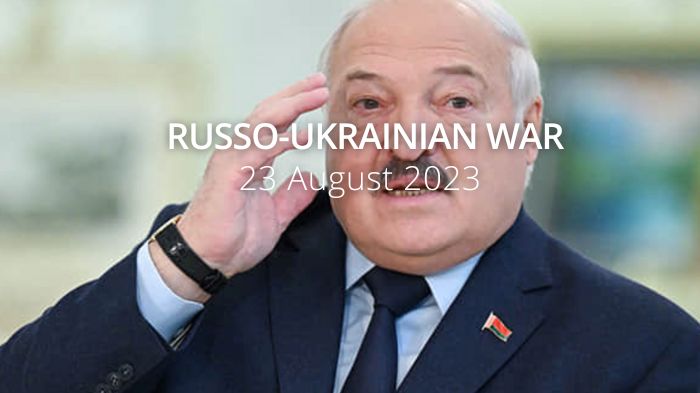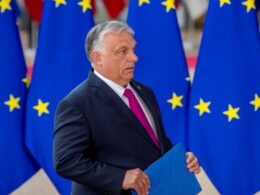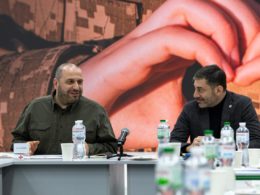US citizens urged to leave Belarus immediately. Five bombers damaged in recent drone attacks on Russian airfields. Ukraine has reached agreements on at least four new packages of military aid from partners.
Morning report day 546 – August 23 2023
According to information from the General Staff as of 06.00 23.08.2023, supplemented by its [18:00 assessment].
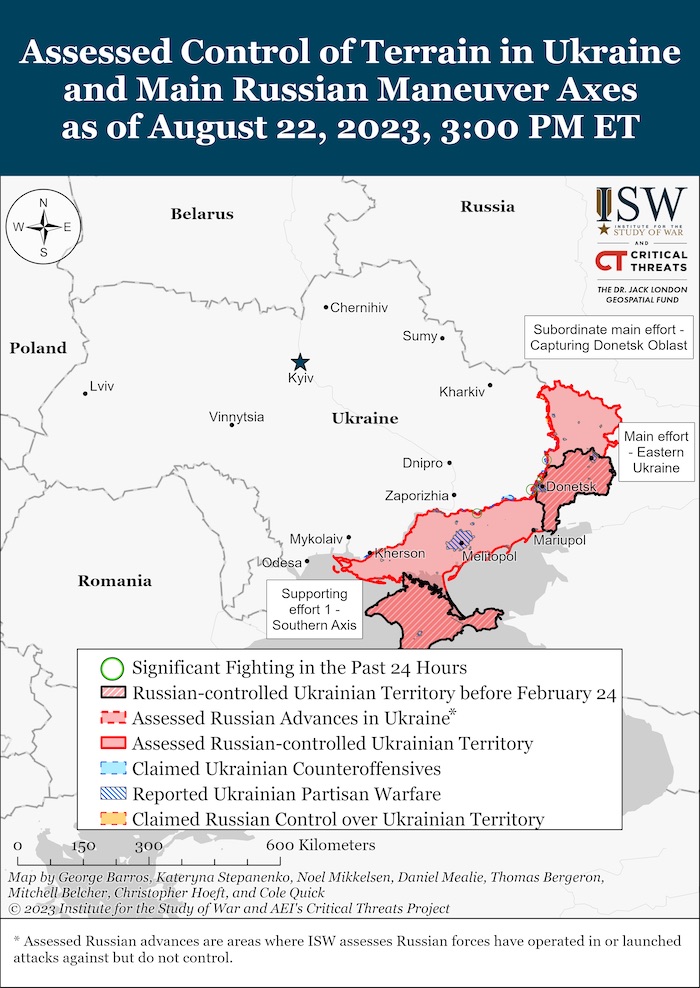
“Last night, the Russian Federation conducted yet another airstrike with Iranian Shahed-136/131 combat UAVs in Ukraine. Information on the aftermath of this terrorist attack is currently being updated.
On August 22, the enemy launched 4 missiles and 58 airstrikes, 60 MLRS attacks at the positions of Ukrainian troops and various settlements. Unfortunately, the Russian terrorist attacks have killed and wounded civilians. Residential buildings and other civilian infrastructure were damaged.
The likelihood of missiles and airstrikes across Ukraine remains high.
On August 22, there were more than 30 combat engagements.
- Volyn and Polissya axes: no significant changes.
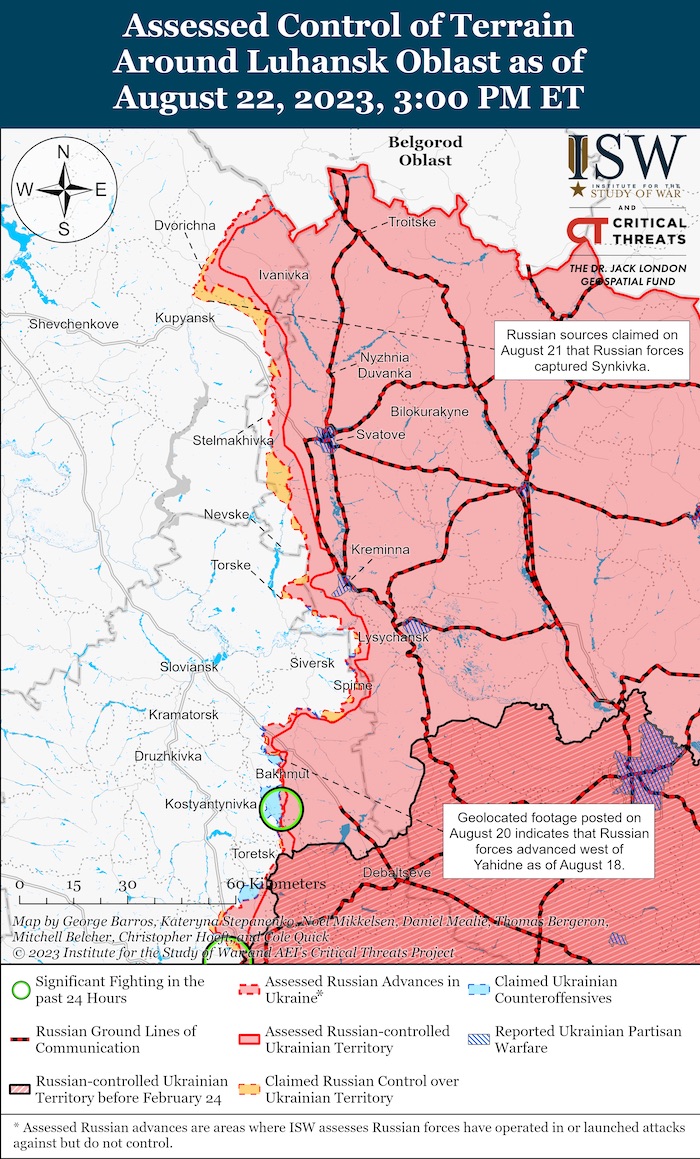
- Sivershchyna and Slobozhanshchyna axes: the adversary launched an airstrike in the vicinity of Popivka (Kharkiv oblast). More than 20 settlements came under mortar and artillery fire, including Bleshnya, Karpovychi, Orlykivka (Chernihiv oblast), Rozhkovychi, Seredyna-Buda, Myropil’s’ke, Ryasne (Sumy oblast), Pletenivka, Vovchans’k, Vovchans’ki Khutory, and Chuhunivka (Kharkiv oblast).
- Kupiansk axis: the settlements of Berestove, Kup’yans’k-Vuzlovyi (Kharkiv oblast), and Tverdokhlibove (Luhansk oblast) came under enemy artillery and mortar fire.
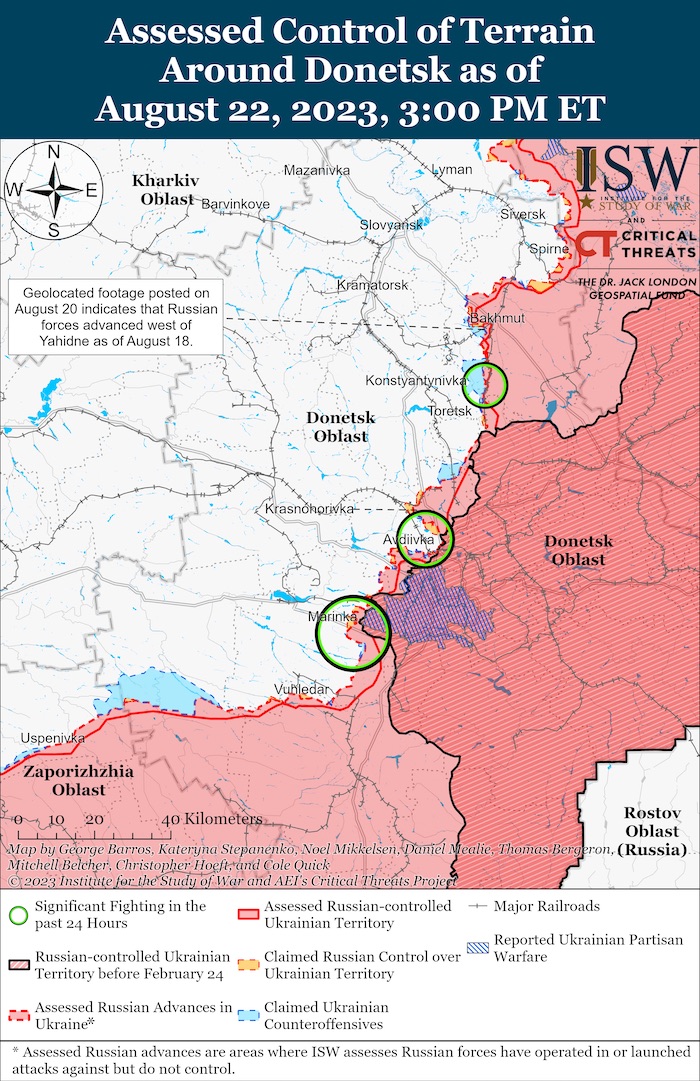
- Lyman axis: the enemy launched airstrikes in the vicinities of Serebryans’ke Forestry (Luhansk Oblast) and Vesele (Donetsk Oblast). The adversary fired artillery at about 15 settlements, including Bilohorivka (Luhansk oblast), Zvanivka, Serebryanka, Sivers’k, Vesele, Spirne, and Fedorivka (Donetsk oblast).
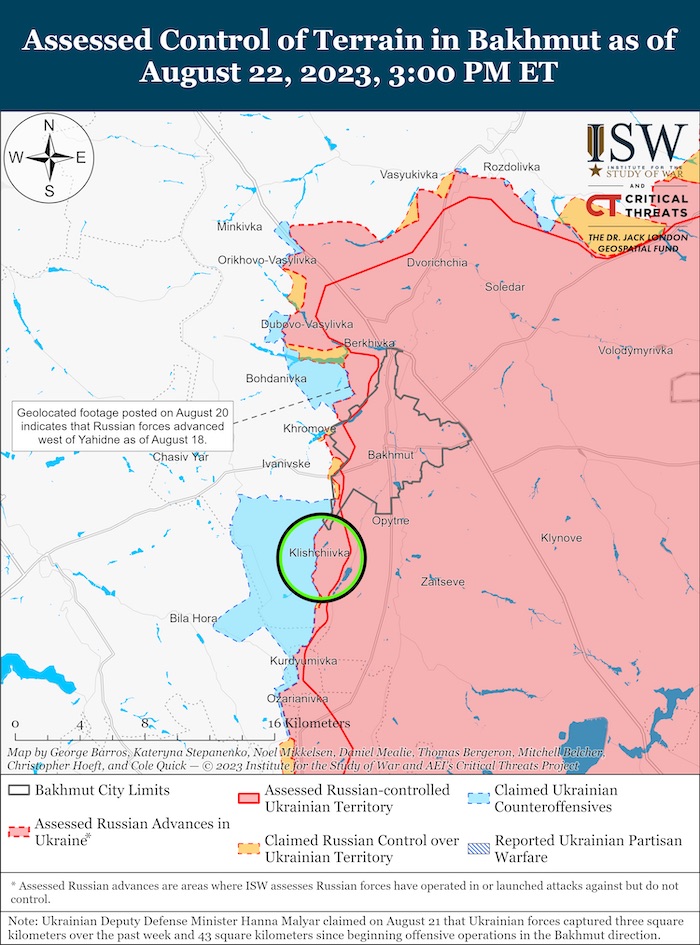
- Bakhmut axis: the enemy launched an airstrike in the vicinity of Ivanivske (Donetsk oblast). More than 20 settlements, including Orikhovo-Vasylivka, Min’kivka, Bohdanivka, Ivanivske, Dyliivka, and New York (Donetsk oblast), suffered from enemy artillery shelling.
- Avdiivka axis: the Ukrainian defenders successfully repelled Russian troops' attacks in the vicinity of Avdiivka. The settlements of Novokalynove, Stepove, Avdiivka, Sjeverne, Tonen’ke, and Umans’ke (Donetsk oblast) came under artillery fire.
- Marinka axis: the Ukrainian Defence Forces continue to hold back the Russian offensive in the vicinity of Mar’inka (Donetsk oblast). The enemy launched an airstrike in the vicinity of Krasnohorivka (Donetsk oblast). The settlements of Mar’inka, Pobjeda, Yelyzavetivka, Novomykhailivka, Katerynivka, Kostiantynivka, and Antonivka (Donetsk oblast) came under artillery fire.
- Shakhtarske axis: the enemy launched airstrikes in the vicinities of Vodyane and Urozhaine (Donetsk oblast). More than 15 settlements, including Vodyane, Vuhledar, Prechystivka, Zolota Nyva, Vremivka, Makarivka, and Urozhaine (Donetsk oblast), suffered from enemy artillery shelling.
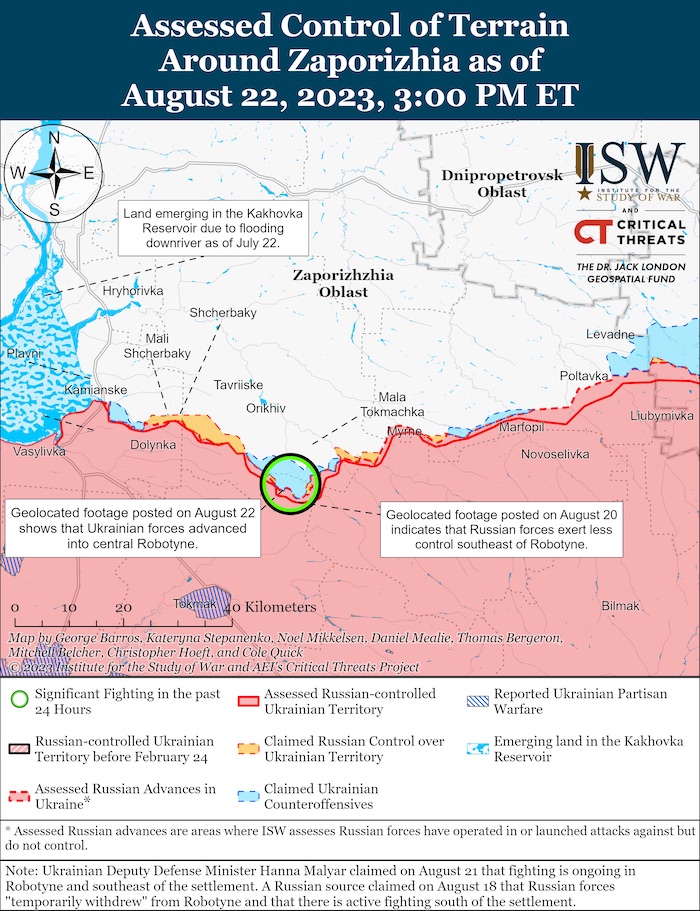
- Zaporizhzhia axis: the adversary launched airstrikes in the vicinities of Mala Tokmachka, Yehorivka, Novodanylivka, and Robotyne (Zaporizhzhia oblast).
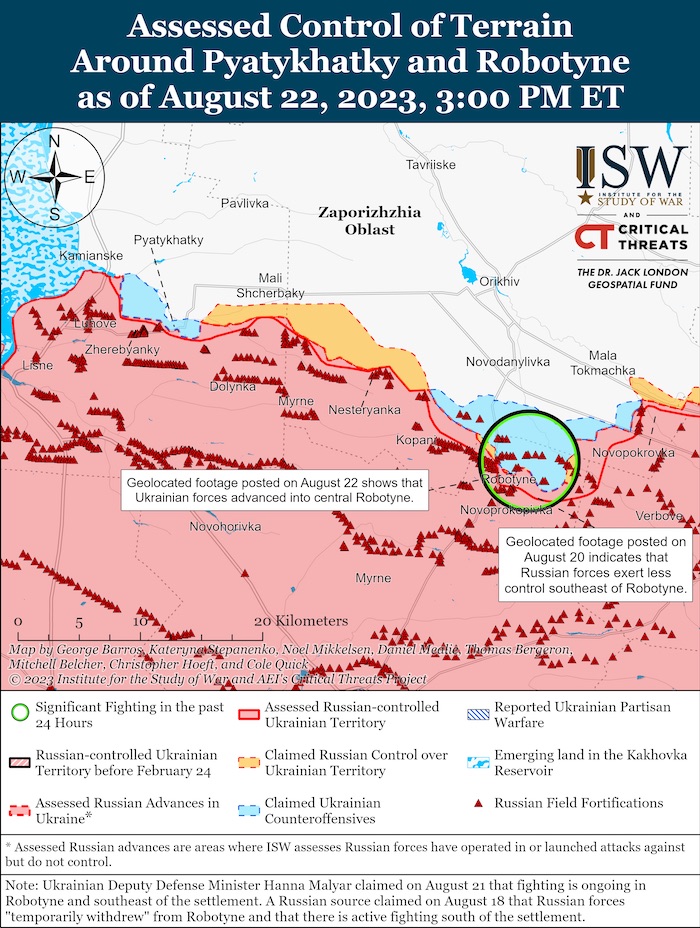
- More than 15 settlements suffered from enemy artillery shelling, including Poltavka, Hulyaipole, Huliaipilske, Charivne, Bilohir’ya, Chervone, and Zatyshshya (Zaporizhzhia oblast).
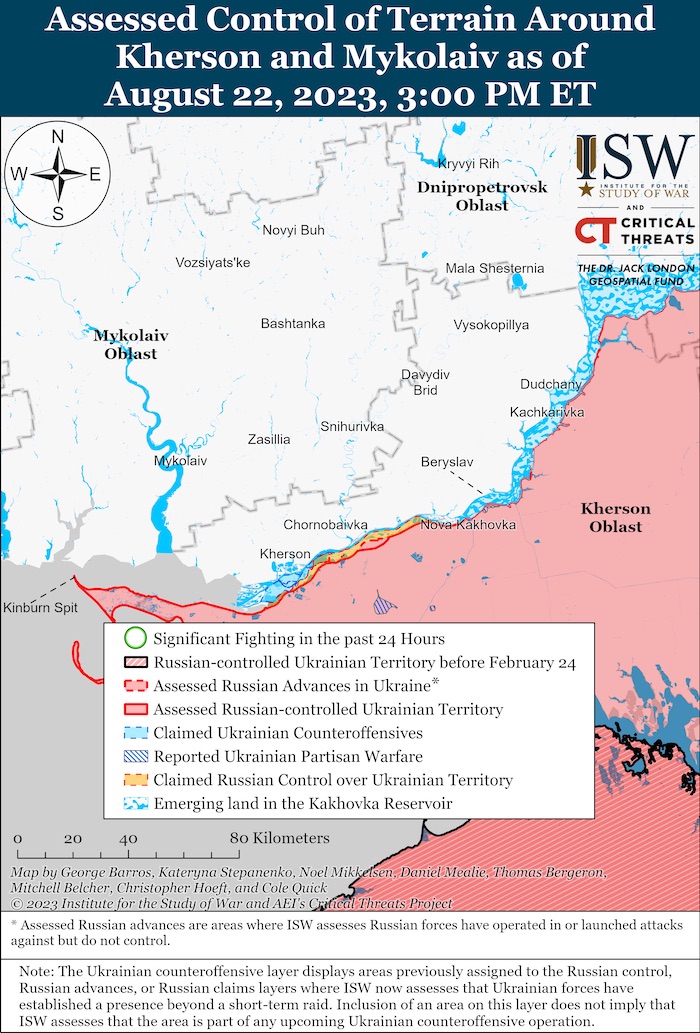
- Kherson axis: the adversary launched an airstrike in the vicinity of Romashkove (Kherson oblast). Novovorontsovka, Kherson, Bilozerka, Veletens’ke, and Komyshany (Kherson oblast) suffered from enemy artillery shelling.
At the same time, the Ukrainian Defence Forces continue to conduct the offensive operation on Melitopol axis, consolidating their positions and conducting counter-battery fire.
On August 22, Ukrainian Air Force launched 11 airstrikes on the concentrations of troops of the adversary and 2 airstrikes on the anti-aircraft missile systems.
On August 22, the Ukrainian missile and artillery troops hit 3 concentrations of personnel, weapons, and military equipment, 2 ammunition depots, 1 command post, 1 artillery system at its firing position, and 1 TOS-1A thermobaric artillery system of the adversary.“
Military Updates
Ukraine defies odds by advancing in counteroffensive - senior official, Reuters reports. “Ukraine has made progress in its counteroffensive against Russian forces simply by proving it can push back a better-armed and numerically superior enemy, a senior Ukrainian official said on Tuesday. Ukrainian troops have faced vast Russian minefields and trenches in the counteroffensive launched in early June, and a US official said last week it looked unlikely that Kyiv would be able to recapture the strategic southern city of Melitopol.
But Deputy Defence Minister Hanna Maliar brushed aside any suggestion that Kyiv's progress was too slow and said Ukraine had effectively defied military doctrine by attacking an enemy that has a numerical advantage in manpower and weaponry. It's incorrect to measure this advance by metres or kilometres, Maliar told Reuters in an interview. What's important is the very fact that despite everything, we're moving forward even though we have fewer people and fewer weapons.
She said she was unaware of any Western pressure being exerted on Ukraine's military to accelerate operations […]. Maliar highlighted the grinding attrition in the war, particularly in Ukraine's east, where she said Russian forces - who also enjoy air superiority - can fire 400,000-500,000 artillery shells each week or around 10 times more than Ukraine. […] Armed with Western tanks and infantry fighting vehicles, Ukraine has retaken a string of villages but no larger settlements. The onset of wetter and colder weather in October may complicate operations on the battlefield. […]
Earlier on Tuesday, she said Ukrainian troops had gained a foothold in the southeastern village of Robotyne on the road to Tokmak, an occupied rail hub whose recapture would be a milestone in Kyiv's southward drive to reach the Sea of Azov. The next major settlement is the big regional city of Melitopol.”
Explosion, smoke reported in Moscow business district – RIA, Reuters reports. “An explosion was heard in Moscow's business district early on Wednesday [23 August], Russia's RIA news agency reported. The agency also said that smoke was seen in the area.”
Russia attacked with drones again, damage caused near Moscow, Ukrainska Pravda reports, citing Russian news agency Astra on Telegram; Russian Telegram channel Baza; Russian Telegram channel Shot; Kremlin-aligned Russian news agency TASS. “The Russian capital was once again attacked by drones on the night of 21-22 August, with a high-rise building and cars damaged in the city of Krasnogorsk, Moscow Oblast.
Astra reported that windows were blown out of houses and cars were damaged in Krasnogorsk after the explosion. The wreckage of a suspected UAV is lying on the tarmac of one of the yards. The explosion was also heard by residents of Moscow's Strogino district, Astra reports. Smoke could be seen in the sky after the explosion.
All the capital’s airports were closed for departures and arrivals, TASS reports, with reference to the aviation authorities.”
US says it does not support Ukrainian strikes inside Russia, Reuters reports. “The United States does not encourage or enable attacks inside Russia, a US State Department spokesperson said after Russian authorities said they downed drones that tried to attack Moscow early on Wednesday. It is up to Ukraine to decide how it chooses to defend itself from the Russian invasion that began in February last year, the State Department spokesperson said, adding Russia could end the war any time by withdrawing from Ukraine.
Drone strikes deep inside Russia have increased since two unmanned aircraft were destroyed over the Kremlin in early May. Drone strikes on the Russian capital have become increasingly common in recent months.”
11 "Shahed-136/131" attack UAVs were destroyed, the Ukrainian General Staff reports. “On the night of August 23, 2023, the enemy launched "Shahed-136/131" attack UAVs from the southeast. In total, up to 20 attack drones were launched from the Primorsko-Akhtarsk region (Russian Federation) and Chauda (Crimea).
The forces and means of the Air Force in cooperation with the air defense of other components of the Defense Forces of Ukraine destroyed 11 enemy drones, nine in Odesa and two in the Zaporizhzhia region.”
According to British Defence Intelligence, (last 48 hours):
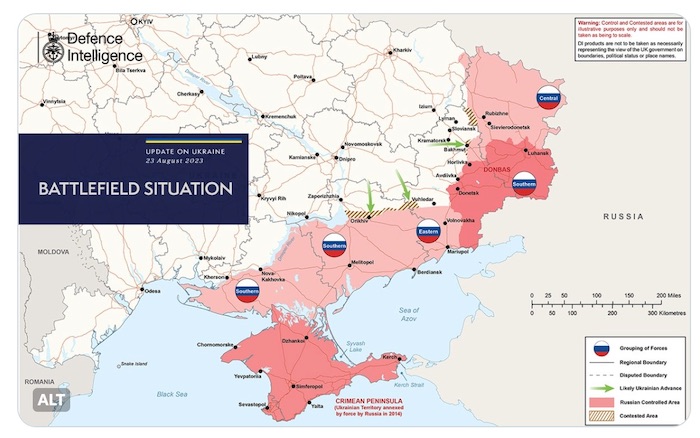
- As of mid-August 2023, Russian forces were continuing to employ pontoon bridges at Chonhar and Henichesk crossing points on the border between southern Ukraine and occupied Crimea. Both permanent bridges sustained damage from Ukrainian precision strikes in early August 2023.
- The pontoon bridges are unlikely to be able to fully sustain the flow of heavy vehicles carrying ammunition and weaponry to the front.
- The resulting bottlenecks mean Russian forces are partially reliant on a long diversion via Armiansk, northern Crimea. This is adding further friction to Russia’s logistics network in the south.
- On 19 August 2023, a Tu-22M3 BACKFIRE medium bomber of Russia’s Long Range Aviation (LRA) was highly likely destroyed at Soltsky-2 Airbase in Novgorod Oblast, 650 km away from Ukraine’s border. The Russian Defence Ministry said that a copter-style uncrewed aerial vehicle (UAV) was responsible for the attack.
- If true, this adds weight to the assessment that some UAV attacks against Russian military targets are being launched from inside Russian territory. Copter UAVs are unlikely to have the range to reach Soltsky-2 from outside Russia.
- Russia has frequently used BACKFIRE bombers to launch the notoriously inaccurate AS-4 KITCHEN heavy anti-ship missiles against Ukraine. Early in the war, they also carried out the intense bombardment of Mariupol using unguided bombs. This is at least the third successful attack on LRA airfields, again raising questions about Russia’s ability to protect strategic locations deep inside the country.
Losses of the Russian Army
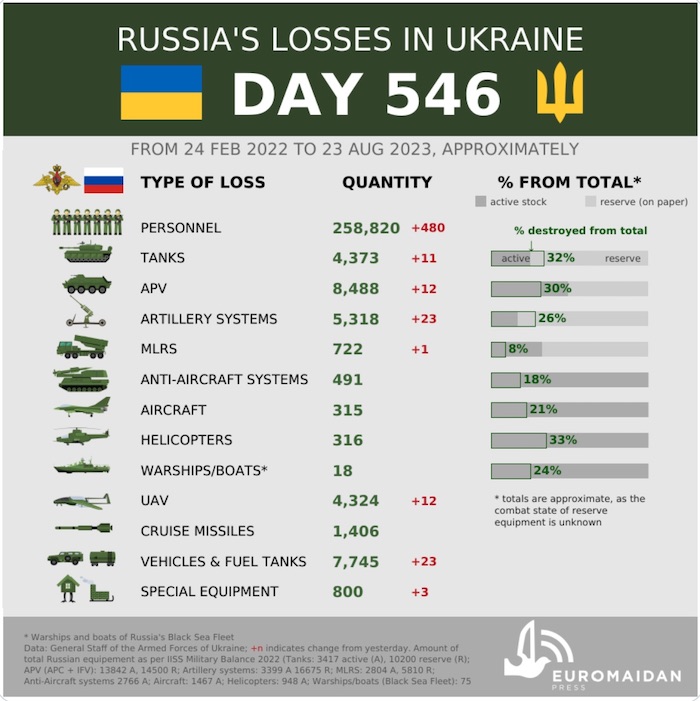
As of Wednesday 23 August, the approximate losses of weapons and military equipment of the Russian Armed Forces from the beginning of the invasion to the present day:
- Personnel – about 258820 (+480)
- Tanks – 4373 (+11)
- Armoured combat vehicles – 8488 (+12)
- Artillery systems – 5318 (+23)
- Multiple rocket launchers –MLRS - 722 (+1)
- Air defence means – 491 (+0)
- Aircraft - 315 (+0)
- Helicopters - 316 (+0)
- Automotive technology and fuel tanks – 7745 (+23)
- Vessels/boats - 18 (+0)
- UAV operational and tactical level – 4324 (+12)
- Special equipment – 800 (+3)
- Mobile SRBM system – 4 (+0)
- Cruise missiles – 1406 (+0)
Five bombers damaged in recent drone attacks on Russian airfields, Ukrinform reports. “As a result of the latest attacks on Soltsy, Novgorod region, and Shaykivka, Kaluga region, both involving unmanned aerial vehicles, a strategic bomber was destroyed and four more were damaged.
The report was confirmed to Ukrinform by sources in Ukraine’s Security and Defense Forces. We confirm this report, the interlocutors told the agency.”
Humanitarian
EU Was Called to Swiftly Extend Temporary Protection for Ukrainian Refugees, European Pravda reports. “The human rights organisation Pro Asyl, which supports asylum seekers in Germany, has urged the European Union to extend the directive on temporary protection for Ukrainian refugees, which is set to expire in March 2024. As reported by DW, citing Neue Osnabrücker Zeitung, human rights advocates believe that EU leaders must officially adopt this decision as quickly as possible, so that people are in greater safety and authorities can prepare properly. They labeled any other outcome as "absurd" in light of the ongoing Russian-Ukrainian war. The same call was made by the Conference of German Cities, which unites several thousand municipalities in Germany.
Helmut Dedí, the managing director of the organisation, stated that cities urgently need guarantees that the EU directive will be extended, creating legal certainty regarding the residency status of refugees from Ukraine. It has proven effective and significantly eased the work on site, he emphasised, also urging for a more flexible system of funding distribution among cities.
According to Engelhard Mazanke, the head of Germany's largest immigration authority in Berlin, Ukrainian refugees want to know this now. This is understandable, because for example, in order to obtain subsidised housing permits, a residence certificate is required for one year, he explained.
The EU adopted the Directive on Temporary Protection to help Ukrainians find shelter and receive assistance with as few obstacles as possible. EU member states even began building temporary Ukrainian 'villages' to better integrate refugees into society. Previously, it was reported that 44% of the over 1 million Ukrainian refugees who came to Germany to escape the war hope to stay in the country. The governments of European countries have allocated over 43 billion euros for sheltering Ukrainians who became refugees due to the war unleashed by Russia.”
Over UAH 3B allocated from budget for restoration of destroyed medical facilities, Ukrinform reports. “More than UAH 3 billion has been allocated from the state budget for the restoration of medical facilities destroyed by Russia, according to the Health Ministry’s press service. Our task is not just to rebuild what was destroyed, but to rebuild it better than it was, taking into account the functionality of each medical facility in accordance with its role in a capable network, Health Minister Viktor Liashko said. […]
As reported, since the full-scale war, 1,598 objects at 639 medical institutions have been damaged by Russian terrorist attacks. As many as 358 objects have been fully restored, another 426 - partially. In total, the international partners estimate the cost of rebuilding and restoring the destroyed facilities at $16.4 billion.”
Environmental
Ukraine’s logistics infrastructure is on the verge of collapse: 25% of bridges are in critical condition, Ukraine Business News reports. “According to the Ministry of Infrastructure of Ukraine, 24% of Ukrainian bridges are completely or partially unusable. The main issues a specialized commission had to resolve are the condition of Ukrainian bridges and to identify the necessary solutions to mitigate all possible risk.
Unfortunately, more than a third of the responsible parties do not have accurate information about the state of their bridges, and a quarter of all structures in the country are in a critical state, Deputy Prime Minister for Reconstruction Oleksandr Kubrakov said. Based on the results of the commission’s work, specific proposals have already been formulated to legislate the priority allocation of funds for the emergency reconstruction or repair of critical bridges.
It is also worth noting that the poor condition of the bridges is caused not only by a lack of funding during wartime but also by constant Russian terrorist attacks, including on logistical infrastructure.”
IAEA experts record explosions near ZNPP, Ukrinform reports, citing a new report released on the agency's website. “On Tuesday, IAEA Director General Rafael Mariano Grossi reported the explosions recently recorded by the agency's experts near the Zaporizhzhia NPP. IAEA reported a strong detonation on August 14 and gunfire on August 16. Another explosion near the site occurred on 17 August, five detonations were heard some distance from the ZNPP on 20 August and five more on 21 August.
The IAEA experts did not observe any explosives and confirmed that the previously reported landmines remain in the same location in between the perimeter fences. The IAEA experts are expecting access to the rooftops of reactor buildings 1, 2, 5 and 6 in the coming days.
The height of the ZNPP cooling pond continues to drop by about 1 centimetre per day while water from the ZTPP inlet channel is regularly pumped into its discharge channel to compensate for water used for cooling or lost through natural evaporation, reads the report. As noted, there was no radioactivity released to the environment arising from the water leak at the steam generator in unit 4.
As a reminder, Grossi stated that the team of experts would closely monitor the process of the transition of the ZNPP unit 4 to cold shutdown and unit 6 to hot shutdown. On August 10, ZNPP started transferring reactor unit 4 to cold shutdown following the detection of a water leak at one of its four steam generators located in the containment of unit 4.”
Legal
Court in The Hague to hear Russia's objections in genocide case, Ukrinform reports, citing the ICJ press service. “The International Court of Justice (ICJ), the principal judicial organ of the United Nations, will hold public hearings on the preliminary objections raised by the Russian Federation in the case concerning Allegations of Genocide under the Convention on the Prevention and Punishment of the Crime of Genocide (Ukraine v. Russian Federation: 32 States intervening) from Monday 18 to Wednesday 27 September 2023, at the Peace Palace in The Hague, the seat of the Court, the statement said. The hearing will be held in two rounds: Russia will speak on September 18 and 25, and Ukraine will present its arguments before the judges on September 19 and 25.
On February 26, 2022, Ukraine filed with the ICJ Registry an application instituting proceeding against Russia concerning the "dispute... relating to the interpretation, application and fulfilment of the 1948 Convention on the Prevention and Punishment of the Crime of Genocide."
Since October 2022, the Russian Federation has raised preliminary objections to the Court's jurisdiction and the admissibility of Ukraine's application. It should be recalled that on March 16, 2022, the International Court of Justice ordered that the Russian Federation immediately cease its invasion of Ukraine.”
42 countries and EU joined formation of international register of damages caused by aggression of Russian Federation against Ukraine, Censor.net reports, citing Prime Minister Denys Shmyhal said this at the international conference "Special tribunal on the crime of aggression against Ukraine. “Justice must be done" in Kyiv. "Another important and key position for Ukraine: Russia must pay, pay for all the damages and losses it has caused to our people. Pay for the restoration of our state. We proposed to the world the concept of an international compensation mechanism, it should consist of a register of losses, a compensation commission and compensation fund. The first element has already been created based on the resolution of the UN General Assembly," Shmyhal said.
He added that 42 countries and the EU joined the formation of the international damage register. We are waiting for the other structural elements of the compensation mechanism to be completed quickly. The key question - where to get the money for confiscation, has a simple answer - from Russian frozen confiscated assets, Shmyhal stressed.
The Prime Minister noted that it is important for Ukraine that the partners provide the appropriate instruments for the transfer of these funds in their legislation as soon as possible. This is also about justice. Convicting criminals and making them pay are two key things, he explained. Shmyhal is convinced that all together - Ukraine and partners should create a precedent of judicial punishment of the guilty and a precedent of payment of funds for restoration.”
Russian prisoners of war are involved in reconstruction of Ukraine, Censor.net reports, citing Andriy Yusov, a representative of the Defence Intelligence of Ukraine, in an interview with Ukrainian News. “According to the Geneva Conventions, they (Russian prisoners of war. - Ed.) have the right to be involved in such (socially useful. - Ed.) work and they are involved. There are such jobs in the Ukrainian prisoner of war camp, he noted. He also informed that Russian prisoners of war receive a small salary, but it is established according to the norms of international law. According to him, there is a shop in the camp where prisoners of war can spend money for their own needs.
Answering the question whether they do not receive money from the budget, Yusov said that one way or another (and international organizations provide assistance), but they receive such funds. For supervision, to ensure security, the employees of this facility work and receive money through the efforts of the Ukrainian state. Of course, such money is allocated, he said.
Answering the question whether there are cases when prisoners of war express a desire to fight against Putin's regime, he confirmed that there are such cases. Among the various divisions where there are citizens of the Russian Federation. They are fighting against Putin's regime. There are people who, after being captured, express their desire not to return to the Russian Federation and with weapons in their hands to defend their honour and future, including that of their country, as they see her, he said.”
Support
Eight Ukrainian pilots begin F-16 training in Denmark, Reuters reports. “Denmark has begun training eight Ukrainian pilots in flying F-16 fighter jets as part of its commitment to donate aircraft to Ukraine, the Danish armed forces said on Tuesday. […]
The eight pilots have arrived at the Danish military air base in Skrydstrup along with 65 personnel who will be trained in maintaining and servicing the jets, the Danish armed forces said in a statement.”
Ukraine has reached agreements on at least four new packages of military aid from partners, Censor.net reports, citing President Zelenskyy during the Veterans Forum, with reference to RBC-Ukraine. “During the visit of President Volodymyr Zelenskyy to four European countries, Ukraine reached important agreements, in particular, at least four new defence aid packages from partners were announced, the main one being the decision on the supply of F-16 fighter jets. […]
In particular, according to him, there are agreements on the specific quantity of the first supply of fighters from the Netherlands and Denmark. However, the president noted that work is underway on an even greater result. […] Ukrainian pilots and engineers will also start training in other countries of the aviation coalition. We are expanding training programs, the head of state added. Earlier, the White House reported that the US supports the decision to provide F-16s to Ukraine after pilot training is completed.
President Zelenskyy, after meeting with the Prime Minister of the Netherlands Rutte, said that the transfer of 42 F-16 aircraft to Ukraine after the training of our pilots is being discussed. And the Netherlands and Denmark undertake to transfer F-16 aircraft to Ukraine. Ukrainian pilots have already started training in Denmark.
The Prime Minister of Denmark Frederiksen said that the country will provide 19 planes. Denmark plans to send the first 6 units to Ukraine closer to the New Year. 70 pilots and aviators are already undergoing training in Denmark. According to Defense Minister Reznikov, the minimum period of preparation is 6 months. At the same time, the commander of the Air Force stated that two pilots will be able to master the F-16 in four months.
The Air Force stated that 128 fighter jets are needed for air superiority in Ukraine. The Pentagon said that the US is ready to train Ukrainian pilots on the F-16 if European countries do not have time. At the same time, the EU can compensate part of the costs of countries that transfer F-16s to Ukraine. Greece will also join the training of Ukrainian pilots.”
Ukrainian ambassador in France announces further batches of long-range SCALP missiles, Ukrainska Pravda reports, citing Vadym Omelchenko, Ukrainian Ambassador to France in an interview with Livyi Bereh news website. “Ukraine has already received the first test batch of long-range SCALP missiles from France, with agreements on further supplies. As the diplomat explained, all the SCALP missiles the French side promised to provide within the first batch are already in Ukraine. This batch was a test batch; the projectiles have proven themselves quite well. There will be SCALPs; the supply will continue. The main issue of these supplies is their rate, and in this regard, the French are doing very well, he added.
Omelchenko noted that France maintains a strict silence on the issue of arms supplies to Ukraine, taking care of the safety of logistics, and after criticism from Ukrainian and French experts, Paris began cautiously announcing supplies of some weapons. […] In July, French President Emmanuel Macron announced the transfer of missiles to Ukraine, which will allow the Ukrainian forces to strike deep into Russia's rear. The media learned then that it was about "significant batches" of SCALP missiles, similar in characteristics to the British-made Storm Shadow long-range missiles.”
Netherlands to give Ukraine about 1,000 portable mine clearing charges, Ukrinform reports. “A decision was made to provide Ukraine with about 1,000 portable mine clearing charges which can make passages in engineering barriers.
"A decision was made to provide Ukraine with about 1,000 portable mine clearing charges which can make passages in engineering barriers," Dutch Defense Minister Kajsa Ollongren said during a meeting with Ukrainian Defense Minister Oleksii Reznikov, Ukrinform reports with reference to the Ministry of Defense.”
"Ukrainian Armored Technology" established joint production of 120-mm mines with two NATO countries, Censor.net reports, citing the company's press service. "Ukrainian Armored Technology" LLC established a joint production of 120 mm mortar rounds with two NATO member countries. The Defense Forces of Ukraine are already receiving thousands of new mortar rounds. It is noted that the 120 mm mortar is currently one of the most common types of artillery weapons of the Ukrainian army. 120 mm mines effectively hit the enemy's manpower and equipment, destroy shelters, fire positions and help the Ukrainian defenders to get closer to Victory.
Mortar shots are manufactured using modern technologies and fully comply with NATO standards. International cooperation and decentralization of production capacities helped our company to increase the monthly volume of deliveries of these ammunitions, - reported in "UB".”
The US plans to increase its production of ammunition to support Ukraine, Ukraine Business News reports. “The intensity of hostilities requires accelerated weapon production, including standard NATO artillery shells, the WP writes. It is planned to double their output soon. The publication notes that the war in Ukraine has resulted in a boon for American defence firms, who are rapidly expanding production capacity.
Experts say that as the US invests in increasing the production of ammunition, drones, air defence missiles, and other weapons that Ukraine needs, it must also ensure that it can maintain expanded capabilities as requirements evolve. Russia’s invasion of Ukraine exposed a NATO-wide ammunition crisis, highlighting critical vulnerabilities in modern warfare. Currently, the US has concentrated on producing 155-mm artillery shells, which have proved critical for Ukraine during the ongoing counteroffensive. The US Defence companies are working as fast as possible.”
At summit in Greece, leaders of 11 countries signed declaration in support of Ukraine, Censor.net reports, citing CNN Greece. “During the Western Balkans summit in Greece, the leaders of 11 countries of south-eastern Europe signed the Athens Declaration in support of Ukraine’s territorial integrity. Thus, the leaders expressed their unwavering support for "Ukraine's independence, sovereignty and territorial integrity within its internationally recognized borders, based on the values of democracy and the rule of law, in the face of Russian aggression.
It also notes that outside the Western Balkans, Ukraine and Moldova, which are geographically adjacent to EU member states, share a common European heritage, and as a strategic investment in peace, security, and stability in Europe, it is important that these regions are accepted as full members of the European family. […]
Russia's invasion of Ukraine is a key moment for Europe, creating a new level of awareness of common principles, unity, and a common future within the EU. This is a critical moment for the security, peace, and stability of our European continent, the declaration reads. It is also noted that the laws and principles that have for so long contributed to a stable and predictable European security order have been violated, and we are once again witnessing the destructive effects of revisionism.
We agreed that there can be no impunity for war crimes and other atrocities, such as attacks on civilians and the destruction of infrastructure, and that all perpetrators must be brought to justice, the document says. We underlined the need for a revitalised and reoriented enlargement process that is tangible and credible, without any detours to the conditions set. We expressed our readiness to support Ukraine and Moldova in taking the next steps in their accession process, once they have completed the necessary reforms, the declaration of the leaders said.”
EU disburses another €1.5B in aid to Ukraine, Ukrinform reports. “We are supporting Ukraine in its efforts to repair, recover and keep the state running. Today we paid a new €1.5 billion to Ukraine,” President of the European Commission Ursula von der Leyen posted on X (formerly known as Twitter). The European Commission President also pledged more aid this year and beyond.
As reported, the Council of the European Union supported on December 10 the European Commission's proposal to disburse additional financial support to Ukraine in 2023. The new program of macro-financial assistance for Ukraine will amount to 18 billion euros. It is expected that preferential loan funds will be transferred to the state budget throughout 2023 in equal parts, taking into account Ukraine's fulfillment of the conditions agreed by the parties. On January 16, Ukraine and the EU signed a Memorandum of Understanding on the provision of 18 billion euros in macro-financial assistance.”
New developments
- 'Finland-2' doesn't happen: Kuleba: Ukraine does not sign agreement with renunciation of territories, Ukrinform reports, citing El Diario. “Ukrainian Foreign Minister Dmytro Kuleba has rejected the possibility of signing a peace agreement with Moscow in exchange for giving up part of Ukrainian territory. Kuleba praised the support Ukraine has received in the fight against Russian aggression. Therefore, he said, the terms of peace for Ukraine cannot resemble the Moscow Peace Treaty signed in 1940 with Finland. […] Kuleba added that having survived a full-scale invasion, won various battles and gained support, Ukraine has every chance to get different peace conditions than it did during the Soviet-'Finland war, the Russia-Georgia war in 2008 or Russia's annexation of Crimea in 2014.”
- Russia already moves nuclear weapons to Belarus – Polish President, Ukrainska Pravda reports, citing AP. “On Tuesday, Polish President Andrzej Duda said Russia is already moving some of its nuclear weapons to Belarus. The Polish president told reporters […] about the implementation of Vladimir Putin's statements that Russia's tactical nuclear weapons will be moved to the territory of Belarus. Indeed, this process is taking place, we are seeing that, Duda said, without giving any details. At the same time, he added that the actions of Moscow and Minsk in an obvious way is changing the architecture of security in our part of Europe."
- Erdoğan to go to Russia for meeting with Putin, Ukrainska Pravda reports, citing Yeni Şafak, a Turkish news outlet. “Turkish President Recep Tayyip Erdoğan is planning to visit Russia to meet with dictator Vladimir Putin to discuss the Black Sea Grain Initiative. The meeting was initially expected to take place in Ankara. The outlet cites sources close to the Erdoğan administration as saying that the Turkish president's visit to Russia is supposedly being prepared and is "critical" for reaching an agreement with Russia on the continuation of the grain initiative. As the sources said, Ankara is of the opinion that creating a new route for grain exports by sea without Russia's participation is not a good idea. Possible dates of Erdoğan’s visit to Russia are not specified.”
- Putin dismisses General Surovikin from his post of commander of Russian Aerospace Forces, Ukrainska Pravda reports, citing Meduza and Radio Liberty, with reference to Alexei Venediktov, former Editor-in-Chief of Echo of Moscow. “Russian dictator Vladimir Putin has dismissed General Sergei Surovikin from the post of commander of the Russian Aerospace Forces. Media reports say Surovikin was detained by Russian counterintelligence in connection with the rebellion led by Yevgeny Prigozhin; the general is known to be the latter's associate. The journalists say Putin's decree also states that Surovikin will be left at the disposal of the Russian Ministry of Defence. This decree was not published officially.”
- US citizens urged to leave Belarus immediately, The Hill reported on 21 August. “The Biden administration is urging US citizens in Belarus to depart the country immediately and warned against travel there in a statement published Monday. The updated travel warning comes after bordering countries Lithuania, Latvia and Poland have stepped up security along the border over concerns about Russian Wagner mercenary forces exiled in the country. The State Department, in its warning, encouraged Americans still in Belarus to depart the country immediately and categorized the country as a Level 4 risk, the highest security warning.”
Assessment
- On the War
The Institute for the Study of War has made the following assessment as of Tuesday 22 August:
(quote) “Ukrainian forces continued to make advances in and around Robotyne in western Zaporizhzhia Oblast as of August 22 amid indications that Russian forces likely have a limited presence in the settlement. Geolocated footage published on August 21 and 22 indicates that Ukrainian forces advanced in southeastern Robotyne and east of the settlement near Novopokrovka (13km southeast of Orikhiv). The Ukrainian 47th Mechanized Brigade published a video on August 22 showing its personnel successfully evacuating civilians from Robotyne while accompanied by Ukrainian journalists. The 47th Mechanized Brigade stated that its personnel broke through multi-echelon Russian defensive lines near Robotyne and have entered the settlement. The evacuations and the presence of Ukrainian journalists suggests that areas of Robotyne may be relatively secure due to diminished Russian positions in the settlement itself and the nearby area. Russian maximalist claims that Ukrainian forces only maintain positions on the very northern outskirts of the settlement are likely false given the footage and reporting from the 47th Brigade. Most Russian milbloggers continue to acknowledge that Ukrainian forces hold positions in much of northern Robotyne and that Russian forces likely control at most positions on the southern outskirts of the settlement at this time.
Russian forces appear to be concentrating their limited available reinforcements from elsewhere in the theater in the Orikhiv direction in western Zaporizhzhia Oblast. Ukrainian military journalist Konstantin Mashovets reported that elements of the 108th Air Assault (VDV) Regiment (7th VDV Division) deployed near Robotyne as of August 16 and near Novopokrovka as of August 20. Elements of the 108th were deployed near the Antonivsky Bridge as of July 29, and the “Sokol” Volunteer Battalion of the 108th VDV Regiment was reportedly operating near Staromayorske and Urozhaine in the Donetsk-Zaporizhzhia Oblast border area as of August 14. Elements of the 7th VDV Division’s 56th Regiment have likely been engaged in fighting in the immediate vicinity of Robotyne since early August. Elements of the 7th VDV Division's 247th Regiment appear to be still operating south of Velyka Novosilka in the Donetsk-Zaporizhzhia Oblast border area, although a prominent Russian milblogger suggested that some elements may be operating in the Robotyne area. Elements of the 7th VDV Division's air assault regiments may be deployed across two axis as separate battalions and platoons, however. ISW previously assessed that the lateral redeployment of elements of the 7th VDV Division to the Robotyne area suggested that Ukrainian forces had severely degraded Russian forces in the area, and the possible commitment of elements of all three of its air assault regiments may suggest the further deterioration of the Russian situation in the area.
Ukrainian offensive operations in other sectors of the front remain important because they can fix Russian units in place and prevent further lateral reinforcements. Criticisms of continued Ukrainian efforts in other sectors and calls for Ukraine to concentrate all available reserves on a single axis are thus problematic. Ukrainian offensive operations around Bakhmut have fixed elements of multiple Russian airborne divisions and separate brigades in that area, as ISW has previously noted, rendering them likely unavailable to stiffen Russian resistance in the south. Ukrainian offensive operations south of Velyka Novosilka proceeding in parallel with operations toward Melitopol present Russian defenders with multiple dilemmas and the need to choose which axis to reinforce. Sound campaign design requires balancing between weighting a decisive main effort and avoiding allowing the enemy to concentrate all reserves on stopping a single obvious thrust.
The Ukrainian advance in the Robotyne area brings Ukrainian forces closer to launching operations against second lines of defense that may be relatively weaker than the first Russian defensive line in the area. ISW has not observed any new Russian formations or units arrive in western Zaporizhzhia Oblast beyond the lateral transfer of the elements of the 7th VDV Division and the arrival of “Akhmat-Yug" Battalion elements in August. Elements of the 503rd Motorized Rifle Regiment (19th Motorized Rifle Division, 58th Combined Arms Army, Southern Military District) previously operating near Nesteryanka (12km northwest of Robotyne) have reportedly arrived in the immediate vicinity of Robotyne, likely to reinforce failing Russian defenses in the area. Russian forces deployed to the wider western Zaporizhzhia Oblast operational direction have been defending against Ukrainian counteroffensives since the start of the counteroffensive without rotation. Russian forces do not appear to have uncommitted regular units in Zaporizhzhia Oblast. All elements of the Russian grouping in Zaporizhzhia Oblast that ISW observed in the area in the months leading up to the counteroffensive have since been engaged in defensive operations in western Zaporizhzhia Oblast or in the Donetsk-Zaporizhzhia Oblast border area. ISW has since observed additional Russian elements that were likely already in the area only after they started defending against Ukrainian counteroffensive operations, however, and it remains possible that some yet unobserved and uncommitted elements may occupy positions at secondary lines of defense.
The lack of observed Russian formations and units at secondary lines of defense in western Zaporizhzhia Oblast may suggest that elements of units and formations already engaged in fighting may occupy these positions. Russian tactical reporting about counterattacks in the Robotyne area suggests that the 22nd and 45th Spetsnaz Brigades occupy positions behind the first line of defense and possibly at the second. Elements of the 22nd and 45th Spetsnaz Brigades appear to be responsible for launching counterattacks against significant Ukrainian advances in the area and therefore are likely degraded. The likely lack of Russian operational reserves, together with the limited lateral transfers to western Zaporizhzhia Oblast and observed separate uncommitted units at second lines of defense, suggests that second lines of Russian defense may be significantly less heavily defended. The Russian formations and units currently occupying secondary lines of defense are largely unknown at this time, however, and ISW offers this assessment with low confidence.
Russian forces appear concerned about recent Ukrainian advances in the Donetsk-Zaporizhzhia Oblast border area and in western Zaporizhzhia Oblast. Satellite imagery from November 2022, December 2022, and August 2023 shows that Russian forces have notably sped up the expansion of defensive fortifications near Chervonoselivka (38km southwest of Velyka Novosilka and 27km from the current frontline) in Zaporizhzhia Oblast over the last month. Ukrainian Colonel Petro Chernyk stated that all conditions are set for Ukrainian forces to enter the Northern Azov region and “demolish“ Russian positions in southern Ukraine and occupied Crimea. Chernyk stated that Russian forces are strengthening their positions on the Perekop Isthmus (around 160km north of Sevastopol) and are building three lines of defense in the area. Chernyk suggested that Russian forces would not have built additional defenses if they were sure they could hold their positions on the Perekop Isthmus. Ukrainian Main Military Intelligence Directorate (GUR) Head Major General Kyrylo Budanov stated that Russian forces have created four unspecified “groups” in Crimea in preparation for a Ukrainian counteroffensive and noted that this has never happened before. The construction of additional defensive fortifications in Zaporizhzhia Oblast and on the Perekop Isthmus and the creation of four unspecified “groups” in Crimea may indicate that Russian forces are growing increasingly concerned about recent Ukrainian advances along the southern front.
Russian President Vladimir Putin reiterated Russia’s unwillingness to renegotiate the Black Sea Grain Initiative until all of Russia’s extensive terms are met during the BRICS Business Forum in South Africa on August 22. Putin claimed that the West ignored obligations to Russia for the export of grain and fertilizer abroad and that the West prevented Russia from transferring free mineral fertilizers to unspecified countries. Putin claimed that Russia has refused to extend the grain deal since July 18 and will continue to refuse until all Russia’s conditions are met. Putin, nevertheless, reiterated Russia’s promise to send six African countries 25,000 to 50,000 tons of grain for free. Putin’s promotion of Russian agricultural exports to Africa is likely aimed at mitigating dissatisfaction from African countries at Russia’s withdrawal from the grain deal and Russia’s destruction of about 180,000 tons of Ukrainian grain, some of which was likely intended for Africa. Putin delivered the remarks via teleconference as Russian and South African concerns about South Africa’s status as a signatory to the International Criminal Court (ICC) and Putin’s ICC arrest warrant have shadowed the BRICS forum in the past months.
Wagner Group financier Yevgeny Prigozhin may be trying to increase Wagner’s presence in Africa as part of an effort to maintain Wagner as a cohesive and independent organization. A Wagner recruitment Telegram channel announced on July 30 that Wagner stopped all recruitment and that all Russian regional recruitment centers suspended work indefinitely before advertising new jobs on August 21. An OSINT monitoring group, “All Eyes on Wagner,” reported on August 22 that Wagner sources have been advertising jobs in the Middle East and Africa following Prigozhin’s August 21 claim that Wagner is expanding its presence in Africa. The advertisement reportedly offers a monthly salary of 150,000 rubles (about $1,500) for jobs in the Middle East and 195,000 to 250,000 rubles (about $2,050 to $2,640) for jobs in Africa. A Wagner recruitment Telegram channel consistently advertised the monthly salary for Wagner positions in Ukraine as 240,000 rubles (about $2,530) since the start of 2023. The significant decrease in salary is consistent with recent reports that Wagner is financially struggling and may be losing personnel due to salary cuts. ISW continues to assess that Wagner‘s new recruitment effort may indicate that Prigozhin is attempting to secure a contract in Africa and deploy existing and new personnel from Russia and Belarus, actions that Prigozhin may see as Wagner’s final option to maintain its independence from the Russian MoD.
A Russian Ministry of Defense (MoD) delegation arrived in Libya on August 22, likely as part of the Russian MoD’s efforts to set conditions to possibly replace the Wagner Group with MoD-affiliated private military companies (PMCs). Libyan National Army Commander Marshal Khalifa Haftar invited the Russian MoD delegation, led by Deputy Defense Minister Colonel General Yunus-Bek Yevkurov, to Libya to discuss bilateral cooperation in combating international terrorism and other issues. ISW has observed evidence indicating that Wagner forces continue to operate in Mali, Libya, and the Central African Republic. The arrival of a Russian MoD delegation in Libya indicates that Russian Defense Minister Sergei Shoigu likely maintains his reported objectives of taking over Russia’s relationships with African countries and replacing Wagner with MoD-affiliated PMCs.
Claims that the Russian MoD formally dismissed nominal Russian deputy theater commander in Ukraine Army General Sergei Surovikin as commander of the Russian Aerospace Forces (VKS) generated a muted response among Russian milbloggers. Russian opposition journalist Alexey Venidiktov claimed on August 22 that the Russian MoD issued a decree dismissing Surovikin as the commander of the VKS. Russian media figure Ksenia Sobchak claimed that the Russian MoD issued a closed decree dismissing Surovikin on August 18. Several Russian milbloggers claimed that news of Surovikin’s alleged dismissal is not new and does not change anything because Russian authorities removed Surovikin from power immediately after Prigozhin’s June 24 rebellion.
The Kremlin is reportedly planning to cancel gubernatorial elections in the Republic of Khakassia in order to prevent a Russian veteran’s loss and ensure a United Russia victory, likely demonstrating the Kremlin’s concern over domestic support for the war and the fragility of its veneer of electoral legitimacy. Russian opposition media outlet Meduza reported on August 21 that the United Russia candidate in the gubernatorial race in the Republic of Khakassia, State Duma deputy and veteran of the war in Ukraine Sergei Sokol, is likely to lose to incumbent Valentin Konovalov of the Communist Party. Kremlin-backed United Russia leadership reportedly realized that primarily promoting Sokol as a veteran of the war in Ukraine was causing voters to question his qualifications to head a regional government and is reportedly now presenting Sokol as an “effective lobbyist” who will be able to garner more support for Khakassia from the federal government. Meduza reported that the Kremlin, in preparation for Sokol’s loss, is planning to cancel the election citing “allegations of falsifications.” The Central Election Commission has already criticized the local election commission for misusing administrative resources in July. The Kremlin will reportedly give Sokol a “compensatory post” in the regional or federal government and conduct new elections with a new United Russia candidate. The Kremlin will reportedly only cancel the elections if the results are close; if Konovalev wins by a significant margin, the Kremlin, according to a Meduza source close to the Presidential Administration, may recognize the results “in order not to inflame the situation.” ISW previously reported that United Russia electoral campaigns are not highlighting the war in Ukraine out of concerns about voter support for the war. ISW also previously reported that the Kremlin likely fears its electoral legitimacy in upcoming elections may weaken, possibly presenting United Russia with a greater need to falsify and manipulate election results.
Key Takeaways:
- Ukrainian forces continued to make advances in and around Robotyne in western Zaporizhzhia Oblast as of August 22 amid indications that Russian forces likely have a limited presence in the settlement.
- Russian forces appear to be concentrating their limited available reinforcements from elsewhere in the theater in the Orikhiv direction in western Zaporizhzhia Oblast.
- Ukrainian offensive operations in other sectors of the front remain important because they can fix Russian units in place and prevent further lateral reinforcements. Criticisms of continued Ukrainian efforts in other sectors and calls for Ukraine to concentrate all available reserves on a single axis are thus problematic.
- The Ukrainian advance in the Robotyne area brings Ukrainian forces closer to launching operations against second lines of defense that may be relatively weaker than the first Russian defensive line in the area.
- Russian forces appear concerned about recent Ukrainian advances in the Donetsk-Zaporizhzhia Oblast border area and in western Zaporizhzhia Oblast.
- Russian President Vladimir Putin reiterated Russia’s unwillingness to renegotiate the Black Sea Grain Initiative until all of Russia’s extensive terms are met during the BRICS Business Forum in South Africa on August 22.
- Wagner Group financier Yevgeny Prigozhin may be trying to increase Wagner’s presence in Africa as part of an effort to maintain Wagner as a cohesive and independent organization.
- A Russian Ministry of Defense (MoD) delegation arrived in Libya on August 22, likely as part of the Russian MoD’s efforts to set conditions to possibly replace the Wagner Group with MoD-affiliated private military companies (PMCs).
- The Kremlin is reportedly planning to cancel gubernatorial elections in the Republic of Khakassia in order to prevent a Russian veteran’s loss and ensure a United Russia victory, likely demonstrating the Kremlin’s concern over domestic support for the war and the fragility of its veneer of electoral legitimacy.
- Russian forces conducted offensive operations along the Kupiansk-Svatove-Kreminna line, near Bakhmut, along the Avdiivka-Donetsk City line, in the western Donetsk-eastern Zaporizhzhia Oblast border area, and in western Zaporizhzhia on August 22 and advanced in certain areas.
- Ukrainian forces conducted offensive operations on at least two sectors of the front on August 22 and made advances near Bakhmut and in western Zaporizhzhia Oblast.
- Russian authorities continue their campaign of religious persecution in occupied Ukraine.“ (unquote)
Ukraine's Defence Intelligence chief announces forthcoming attacks in Crimea, Ukrainska Pravda reports. “Kyrylo Budanov, Chief of Ukraine's Defence Intelligence, promises new cases of "destruction of the invaders" in the Russian-occupied Crimea "soon". Budanov says there are people in Ukraine who are afraid of the liberation of Crimea, but there are also many who are looking forward to seeing it. And they need to be given hope.
That's why we have to hold such events as the Crimean Platform, [and the] events, let's say, [arranged by] resistance movements in the temporarily occupied territories, and simply destroy the invaders in our Crimea. You already see what is being done basically, and you will see more soon."
War is dynamic, Ukraine continues to reclaim territories, Ukrainska Pravda reports, citing Reuters. “On Tuesday, Jake Sullivan, US national security adviser, rejected claims that Russia's full-scale invasion of Ukraine has allegedly stalled. Sullivan says the United States was clearly aware from the beginning that Ukraine's battlefield is very dynamic: There is attacking and defending taking place on both sides at multiple points along a very extended frontline. We are seeing it [Ukraine] continue to take territory on a methodical, systematic basis, Sullivan added.
At the end of last week, The Washington Post, citing sources in US intelligence, reported that during counteroffensive operations, Ukraine allegedly could not achieve its key goal – the city of Melitopol, Zaporizhzhia Oblast. Biden's national security adviser then replied that the situation on the battlefield in Ukraine was constantly changing, and the United States believed in the ability of Ukrainian forces to succeed.”
Ukraine’s Forces and firepower are misallocated, US officials say, The New York Times reports. “American strategists say Ukraine’s troops are too spread out and need to concentrate along the counteroffensive’s main front in the south. Øverst i skjemaet
Nederst i skjemaet
Ukraine’s grinding counteroffensive is struggling to break through entrenched Russian defenses in large part because it has too many troops, including some of its best combat units, in the wrong places, American and other Western officials say. The main goal of the counteroffensive is to cut off Russian supply lines in southern Ukraine by severing the so-called land bridge between Russia and the occupied Crimean Peninsula. But instead of focusing on that, Ukrainian commanders have divided troops and firepower roughly equally between the east and the south, the US officials said.
As a result, more Ukrainian forces are near Bakhmut and other cities in the east than are near Melitopol and Zaporizhzhia in the south, both far more strategically significant fronts, officials say. American planners have advised Ukraine to concentrate on the front driving toward Melitopol, Kyiv’s top priority, and on punching through Russian minefields and other defenses, even if the Ukrainians lose more soldiers and equipment in the process. Only with a change of tactics and a dramatic move can the tempo of the counteroffensive change, said one US official, who like the other half a dozen Western officials interviewed for this article spoke on the condition of anonymity to discuss internal deliberations.
Another US official said the Ukrainians were too spread out and needed to consolidate their combat power in one place. Nearly three months into the counteroffensive, the Ukrainians may be taking the advice to heart, especially as casualties continue to mount and Russia still holds an edge in troops and equipment.
In a video teleconference on Aug. 10, Gen. Mark A. Milley, the chairman of the Joint Chiefs of Staff; his British counterpart, Adm. Sir Tony Radakin; and Gen. Christopher Cavoli, the top US commander in Europe, urged Ukraine’s most senior military commander, Gen. Valeriy Zaluzhnyi, to focus on one main front. And, according to two officials briefed on the call, General Zaluzhnyi agreed. […]
American officials say there are indications that Ukraine has started to shift some of its more seasoned combat forces from the east to the south. But even the most experienced units have been reconstituted a number of times after taking heavy casualties. These units rely on a shrinking cadre of senior commanders. Some platoons are mostly staffed by soldiers who have been wounded and returned to fight.
Ukraine has penetrated at least one layer of Russian defenses in the south in recent days and is increasing the pressure, US and Ukrainian officials said. It is close to taking control of Robotyne, a village in the south that is near the next line of Russian defenses. Taking the village, American officials said, would be a good sign. […] But some analysts say the progress may be too little too late. The fighting is taking place on mostly flat, unforgiving terrain, which favors the defenders. The Russians are battling from concealed positions that Ukrainian soldiers often see only when they are feet away. Hours after Ukrainians clear a field of mines, the Russians sometimes fire another rocket that disperses more of them at the same location.
Under American war doctrine, there is always a main effort to ensure that maximum resources go to a single front, even if supporting forces are fighting in other areas to hedge against failure or spread-out enemy defenses. But Ukraine and Russia fight under old Soviet Communist doctrine, which seeks to minimize rivalries among factions of the army by providing equal amounts of manpower and equipment across commands. Both armies have failed to prioritize their most important objectives, officials say. […]
American officials’ criticisms of Ukraine’s counteroffensive are often cast through the lens of a generation of military officers who have never experienced a war of this scale and intensity. Moreover, American war doctrine has never been tested in an environment like Ukraine’s, where Russian electronic warfare jams communications and GPS, and neither military has been able to achieve air superiority. American officials said Ukraine has another month to six weeks before rainy conditions force a pause in the counteroffensive. Already in August, Ukraine has postponed at least one offensive drive because of rain. Terrain conditions are always fundamental drivers of military operations, General Milley said in an interview with reporters on Sunday. Fall and spring are not optimal for combined arms operations. […]
More important than the weather, some analysts say, is that Ukraine’s main assault forces may run out of steam by mid- to late September. About a month ago, Ukraine rotated in a second wave of troops to replace an initial force that failed to break through Russian defenses. Ukraine also shifted its battlefield tactics then, returning to its old ways of wearing down Russian forces with artillery and long-range missiles instead of plunging into minefields under fire. In recent days, Ukraine has started tapping into its last strategic reserves — air mobile brigades intended to exploit any breakthrough. While fighting could continue for months, US and other Western officials say Ukraine’s counter-offensive would not have enough decisive firepower to reclaim much of the 20 percent of the country that Russia occupies.
US officials say they do not believe the counteroffensive is doomed to failure but acknowledge that the Ukrainians have not had the success that they or their allies hoped for when the push began. We do not assess that the conflict is a stalemate, Jake Sullivan, the White House’s national security adviser, said on Tuesday. We continue to support Ukraine in its effort to take territory as part of this counteroffensive, and we are seeing it continue to take territory on a methodical systematic basis.”
While a smaller, dug-in Russian force has performed better in the south than American officials and analysts anticipated, the Kremlin still has systemic problems. Russian troops suffer from poor supply lines, low morale and bad logistics, a senior US military official said. But Russia is keeping with its traditional way of fighting land wars in Europe: performing poorly in the opening months or years before adapting and persevering as the fighting drags on.
By contrast, Ukrainian troops, in launching the counteroffensive, have the steeper hill to climb, the official said. It took them more than two months — rather than the week or so that officials initially thought — to get through the initial Russian defenses. Several US officials said they expect Ukraine to make it about halfway to the Sea of Azov by winter, when cold weather may dictate another pause in the fighting. The senior US official said that would be a partial success. Some analysts say the counteroffensive will fall short of even that more limited goal.
Even if the counteroffensive fails to reach the coast, officials and analysts say if it can make it far enough to put the coastal road within range of Ukrainian artillery and other strikes, it could cause even more problems for Russian forces in the south who depend on that route for supplies.”
F-16 can change everything and clear sky of Russian aviation, Censor.net reports, citing Air Force spokesman Yuriy Ignat. "The F-16 is the weapon that will be able to change everything. If today we see huge aviation activity on our radars, monitors. This does not allow our ground troops to effectively carry out offensive actions and liberate our territories today. They (Russians. - Ed.) use the support of their own air defence, which is quite powerful. They use aviation support. This applies to helicopters, fighters, bombers, and attack aircraft. We need to clear the sky of them. F-16 can clean it," he emphasized.
So yes, airplanes are cool, but we still need partners to supply all that he has under his wings. All the payload that can send Russian ships, their warehouses, command posts and aircraft of various types to the bottom quite quickly, Ignat added. He noted that Ukraine expects to receive F-16 in good modifications that will be able to ensure this result.”
Russians flood ferries in Kerch Strait to protect Crimean Bridge – Defence Intelligence, Ukrainska Pravda reports, citing the press service of the Defence Intelligence of Ukraine. “Russians began flooding ferries in the Kerch Strait to protect the Crimean Bridge from attacks; it is planned to flood at least six watercraft. Russian invaders are carrying out preparatory work to flood the second ferry, in the Kerch Strait area, near the illegal bridge between Russia and the temporarily occupied Crimea (coordinates: 45.2432237; 36.5845773)."
It is reported that Russians plan to flood at least six ferries to create a protective strip in front of the bridge. At the same time, the Russians intend to install containment booms between the flooded ferries. Defence Intelligence notes that a simple measure of protection of the nineteen-kilometre bridge in the form of flooding ferries only indicates the feverish decisions of Russians and an intellectual crisis within the country's military and political leadership.”
‘Putin Has Never Been Worse’ – Some Russians Are (Privately) Talking About an Uprising, Kyiv Post reported on 20 August. “In an intercepted phone call, two men hark back to a “golden age” before Putin, adding Russians today are behaving “like wolves” and need to “wait for the people to rise.” Russian citizens overheard in an intercepted phone call predict their country “might never recover” if President Putin stays in power, claiming there are widespread discussions in their places of work about potential uprisings against the Kremlin.
In the recording published by Ukraine’s Military Intelligence (DIU), two Russians decry the current regime, saying the country needs radical change to survive. There was a golden time [before Putin], speaker 1 says. People were normal; they loved, respected, and helped each other. And now they've turned into something like wolves. We might need to live another 100 years to reach the standards of the 1980s... considering what these individuals have done. And if they stay in power for another 10 years, we might never recover.
His friend replies: We have to wait for the people to rise and take action. Nothing else. His friend agrees, adding: At work, everyone talks about it all the time. They say, We’re fighting the wrong battle; we must go [to Moscow] and maybe establish order.
They then recall the failed rebellion by Wagner earlier in the summer, pointing out the mercenary group’s chief Yevgeny Prigozhin, nearly reached the Russian capital not even in a day, but in 12 hours. Referring to the hastily arranged deal that brought an end to the mutiny, speaker 2 says: Well, yes, Putin moved conscripts near Moscow and armed students. Prigozhin didn’t want this bloodshed. He adds: Well, Putin doesn’t care. He cares only for the money, the power, for his own a**. This regime has never been worse.
While the call may be evidence of discontent among the Russian population at Putin’s rule, public protests against the Kremlin or its full-scale invasion of Ukraine have been almost non-existent. Widespread protests did break out in some cities last September, but these were in reaction to new conscription laws rather than Russia’s war against Ukraine. Intercepted phones calls published by Ukraine’s military intelligence have provided numerous insights into the situation faced by Russians over the last few months, particularly soldiers.”
- Consequences and what to do?
In Ukraine, 72% of military servicemen concerned about their future - Minister for Veterans’ Affairs, Ukrinform reports, citing the Minister for Veterans’ Affairs, Yulia Laputina. “We have 72% with anxiety about post-war life, while 75% have faced problems with military physical examinations. People experience anxiety about who will be meeting them in their community and back home. After all, there may be situations where someone returns to their community, and their family remains abroad due to military aggression. Their business has been destroyed, they have no job, and they don’t know where to go," said Laputina.
The minister noted that in 2022, a total of 64,469 social and psychological assistance services were rendered to war veterans. In addition, over 15,000 appeals were received and over 700 legal consultation sessions were conducted since the hotline was launched by the Ukrainian Veterans' Fund. According to Laputina, six Veteran Development Centers have already been deployed across Ukraine, and six more are set to be launched by the end of the year. She added that after Ukraine achieves victory in the war with Russia, more than four million people will be involved in veteran-related policies.”
Hans Petter Midttun: “We seek stability and predictability in the Euro-Atlantic area and between NATO and Russia. NATO does not seek confrontation and poses no threat to Russia. In light of its hostile policies and actions, we cannot consider Russia to be our partner. Any change in our relationship depends on Russia halting its aggressive behaviour and fully complying with international law. We remain willing to keep open channels of communication with Moscow to manage and mitigate risks, prevent escalation, and increase transparency.” (Vilnius Summit Communiqué)
Western leaders remain firm in the conviction that a Western misstep in Ukraine could start a broader confrontation with Russia and – in the worst case – a World War III. For the last 9,5 years, they have feared that Western support to Ukraine – that being any kind of defence aid or military intervention - could result in an escalation of the war into a broader confrontation.
The West has feared that:
- any kind of weapons would trigger an escalation. After having provided everything short of combat aircraft and ATACAMS, Russia has not yet escalated the military confrontation beyond Ukraine.
- attacks against legal targets on Russian territories would trigger an escalation. After multiple Ukrainian strikes against Moscow, airbases for long-range strategic bombers and naval bases, Russia has not yet escalated the military confrontation beyond Ukraine.
- Freedom of Navigation Operation (FONOPS) in the Black Sea would trigger an escalation. After multiple Ukrainian strikes unmanned surface vessel (USV) and missile attacks against the Russian Black Sea Fleet (BSF), Russia has not yet escalated the military confrontation beyond Ukraine.
The US and parts of Europe still believe that military intervention in Ukraine – not as an attack on the Russian Federation but for the defence of a sovereign and independent country – will start a broader military confrontation between Russia and NATO.
Even a Ukrainian NATO membership in line with the Charter of Paris for a New Europe which recognize the freedom of States to choose their own security arrangements, is seen as an action that could drag the Alliance into a war with Russia.
Despite Ukraine’s repeated breaches of Russia’s “red lines”, the West remain fearful of acting in a manner that might lead to an escalation of what already is a Russian-instigated Hybrid War into a full-fledged war.
In my humble opinion, these are political considerations. Furthermore, they are only relevant if there are reasons to believe that the war can be resolved through political means.
That hope ended on 20 February 2014 when Russia decided to wage war against its neighbour because it sought democracy instead of autocracy. Russia actively nourished the hope for a political solution to its war of aggression while it prepared for the full-scale invasion (and tested Western resolve). Any lingering hope for a political solution to the war ended on 24 February 2022.
Russia intends to fulfil its strategic aim and objectives using military power. As clearly stated on 17 December 2021, its strategic aim and objectives go far beyond Ukraine. Only military power will convince it that its aim and objectives are unobtainable.
This becomes even more crucial when acknowledging the fundamental nature of Russia’s war of aggression. It has put the very foundation of the state at risk in the pursuit of Great Power status, a sphere of special interest covering all the former Soviet member states and the integration of Ukraine and Belarus into the Russian Federation. The potential gains from the war – hoping to control Ukraine’s enormous natural resources and vast technology – far outweigh the costs inflicted upon it by the international community. A victory is needed to create the economic, technological, and demographic basis for its Great Power aspirations.
“The Euro-Atlantic area is not at peace. The Russian Federation has violated the norms and principles that contributed to a stable and predictable European security order. We cannot discount the possibility of an attack against Allies’ sovereignty and territorial integrity.” (NATO’s Strategic Concept 2022)
In my opinion, politics must, at least temporarily, take a back seat to sound military strategy.
The distressing fact is that despite the political hope for de-escalation, the war will continue to escalate.
Russia has already turned peace into a full-scale war. It has long engaged both Europe and the US in a Hybrid War. Worse, the war has continued to escalate since 24 February 2022. That’s reflected both in Ukraine and beyond.
Whenever the West believes that Russia has done its worse, it does even worse.
The escalation includes – but is not limited to – its massive attacks on critical infrastructure in Ukraine, its weaponization of food and energy supplies globally, the destruction of the Kakhovka dam and its Nuclear Blackmail.
All of these are happening because the international community allows it to happen.
The war will continue to escalate as Ukraine is fighting for its right to exist and Russia fails to find an off-ramp.
The War of Drones will escalate as both Russia and Ukraine are developing their capabilities. The world will witness a war never seen before.
Ukraine will succeed in turning Crimea into an island. I am in no doubt that its attempt to cut the Russian Ground Lines of Communication along the Sea of Azov will be successful. It will also destroy all bridges linking the peninsula to mainland Russia and Ukraine. Russia will be facing increasing problems sustaining both its forces in southern Ukraine and Crimea.
Ukrainian surface drones will increasingly challenge Russia’s attempt to turn the Black Sea into a Russian lake. The BSF will remain unable to ensure its own safety or the safety of any commercial vessel bound for Russian ports. The economic war will, consequently, increase in severity.
As previously argued, Russia will never accept being defeated by Ukraine (and a country that in its perception, does not exist). Ironically, the one option that the West fears the most - a NATO military intervention - would offer it an off-ramp in the face of a strategic defeat. In the absence of Western will to intervene, however, Russia will at one stage be forced to mobilise. The calls from the Russian ultranationalist community for Russia to do more and worse are growing louder as their frustration increase.
Additionally, the present war remains highly dynamic. The war will change nature and escalate the moment Ukraine potentially loses its Air Defence. It is running out of Soviet legacy AD missiles and the inflow of Western-made systems is slow and incremental. Some of the systems are still under production and are not expected to be delivered before November 2025. Additionally, Ukrainian energy and transport infrastructure is increasingly vulnerable after 18 months of full-scale war. Its access to ammunition remains problematic. The inflow of Defence aid is slowing down as the West is slowly running out of weapons it can provide without undermining its own security.
The bottom line is that the war will continue to escalate in the time to come. The question is whether it will happen on Russian or Western terms.
It will remain on Russia’s terms until the West decides to escalate to de-escalate.
I have consistently argued in favour of Ukrainian NATO membership and/or military intervention (xx weeks from the date of the decision to allow Russia time to withdraw).
An escalation is not an on/off switch. It is not a black-and-white situation. Russia has for the last 9,5 years demonstrated that European security can escalate from peace to crisis, conflict, and war. It's time for the West to demonstrate the ability to de-escalate tension. That, however, requires it to take the initiative and temporarily escalate: Ukrainian NATO membership and/or military intervention.
Will Russia like it? Not at all. Will it try to blackmail the world into submission? Absolutely. Will it stay and fight both Ukraine and the collective West? Not a chance because it would run the risk of losing everything. Will it use nuclear weapons? No, it will not. There are no scenarios in which a nuclear war serves Russian interests. It runs the risk of mutual destruction. It will lose the support of both China and India. It runs contrary to the purpose of the war itself. Not least, its use runs contrary to its nuclear doctrine.
The West needs to get over its fear of escalation. Escalation is very much needed to convince Russia that peace is a better solution than war.

